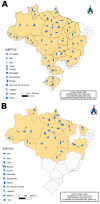Isolation of Flaviviruses and Alphaviruses with Encephalitogenic Potential Diagnosed by Evandro Chagas Institute (Pará, Brazil) in the Period of 1954-2022: Six Decades of Discoveries
- PMID: 37112917
- PMCID: PMC10146763
- DOI: 10.3390/v15040935
Isolation of Flaviviruses and Alphaviruses with Encephalitogenic Potential Diagnosed by Evandro Chagas Institute (Pará, Brazil) in the Period of 1954-2022: Six Decades of Discoveries
Abstract
Viruses with encephalitogenic potential can cause neurological conditions of clinical and epidemiological importance, such as Saint Louis encephalitis virus, Venezuelan equine encephalitis virus, Eastern equine encephalitis virus, Western equine encephalitis virus, Dengue virus, Zika virus, Chikungunya virus, Mayaro virus and West Nile virus. The objective of the present study was to determine the number of arboviruses with neuroinvasive potential isolated in Brazil that corresponds to the collection of viral samples belonging to the Department of Arbovirology and Hemorrhagic Fevers, Evandro Chagas Institute (SAARB/IEC) of the Laboratory Network of National Reference for Arbovirus Diagnosis from 1954 to 2022. In the analyzed period, a total of 1,347 arbovirus samples with encephalitogenic potential were isolated from mice; 5,065 human samples were isolated exclusively by cell culture; and 676 viruses were isolated from mosquitoes. The emergence of new arboviruses may be responsible for diseases still unknown to humans, making the Amazon region a hotspot for infectious diseases due to its fauna and flora species characteristics. The detection of circulating arboviruses with the potential to cause neuroinvasive diseases is constant, which justifies the continuation of active epidemiological surveillance work that offers adequate support to the public health system regarding the virological diagnosis of circulating arboviruses in Brazil.
Keywords: arbovirus; cell culture; neurotropic; public health; viral isolation.
Conflict of interest statement
The authors declare no conflict of interest.
Figures








Similar articles
-
Arbovirus investigation in patients from Mato Grosso during Zika and Chikungunya virus introdution in Brazil, 2015-2016.Acta Trop. 2019 Feb;190:395-402. doi: 10.1016/j.actatropica.2018.12.019. Epub 2018 Dec 12. Acta Trop. 2019. PMID: 30552880
-
Prevalence of arbovirus antibodies in young healthy adult population in Brazil.Parasit Vectors. 2021 Aug 14;14(1):403. doi: 10.1186/s13071-021-04901-4. Parasit Vectors. 2021. PMID: 34391467 Free PMC article.
-
Chikungunya, Zika, Mayaro, and Equine Encephalitis virus detection in adult Culicinae from South Central Mato Grosso, Brazil, during the rainy season of 2018.Braz J Microbiol. 2022 Mar;53(1):63-70. doi: 10.1007/s42770-021-00646-5. Epub 2021 Nov 17. Braz J Microbiol. 2022. PMID: 34787837 Free PMC article.
-
Human Urban Arboviruses Can Infect Wild Animals and Jump to Sylvatic Maintenance Cycles in South America.Front Cell Infect Microbiol. 2019 Jul 17;9:259. doi: 10.3389/fcimb.2019.00259. eCollection 2019. Front Cell Infect Microbiol. 2019. PMID: 31380302 Free PMC article. Review.
-
Review of -omics studies on mosquito-borne viruses of the Flavivirus genus.Virus Res. 2022 Jan 2;307:198610. doi: 10.1016/j.virusres.2021.198610. Epub 2021 Oct 27. Virus Res. 2022. PMID: 34718046 Review.
Cited by
-
Investigation of RNA Viruses in Culicoides Latreille, 1809 (Diptera: Ceratopogonidae) in a Mining Complex in the Southeastern Region of the Brazilian Amazon.Viruses. 2024 Nov 29;16(12):1862. doi: 10.3390/v16121862. Viruses. 2024. PMID: 39772171 Free PMC article.
-
Advances in antiviral strategies targeting mosquito-borne viruses: cellular, viral, and immune-related approaches.Virol J. 2025 Feb 4;22(1):26. doi: 10.1186/s12985-025-02622-z. Virol J. 2025. PMID: 39905499 Free PMC article. Review.
-
Square the Circle: Diversity of Viral Pathogens Causing Neuro-Infectious Diseases.Viruses. 2024 May 15;16(5):787. doi: 10.3390/v16050787. Viruses. 2024. PMID: 38793668 Free PMC article. Review.
-
Bussuquara Virus: A Neglected Orthoflavivirus with Broad Distribution Across Central and South America and the Caribbean.Viruses. 2025 Jan 27;17(2):183. doi: 10.3390/v17020183. Viruses. 2025. PMID: 40006938 Free PMC article. Review.
-
The Landscape of High-Containment Biological Laboratories in Brazil: Current Status and Perspectives.Appl Biosaf. 2025 Mar 7;30(1):55-64. doi: 10.1089/apb.2024.0010. eCollection 2025 Mar. Appl Biosaf. 2025. PMID: 40151382
References
-
- Travassos da Rosa A.P.A., Vasconcelos P.F.C., Pinheiro F.P., Travassos da Rosa J.F.S., Rodrigues S.G. Dengue. In: Leão R.N.Q., editor. Doenças Infecciosas e Parasitárias: Enfoque Amazônico. CEJUP; Belém, Brazil: 1997. pp. 227–241.
-
- WHO (World Health Organization) Technical Report Series, n. 719. World Health Organization; Geneva, Switzerland: 1985. Arthropod-borne and rodent-borne viral diseases. - PubMed
-
- Brazil Ministry of Health . Manual de Vigilância Sentinela de Doenças Neuroinvasivas por Arbovírus. Ministry of Health; Brasília, Brazil: 2017.
-
- CDC (Centers for Disease Control and Prevention) Arboviral Diseases, Neuroinvasive and Non-Neuroinvasive. [(accessed on 17 March 2022)]; Available online: https://ndc.services.cdc.gov/case-definitions/arboviral-diseases-neuroin...
MeSH terms
LinkOut - more resources
Full Text Sources
Medical

